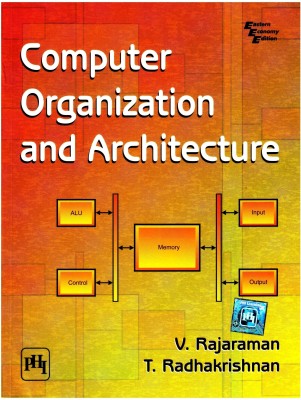Computer Organization and Architecture(English, Paperback, Rajaraman V.)
Quick Overview
Product Price Comparison
Designed as an introductory text for the students of computer science, computer applications, electronics engineering and information technology for their first course on the organization and architecture of computers, this accessible, student friendly text gives a clear and in-depth analysis of the basic principles underlying the subject. This self-contained text devotes one full chapter to the basics of digital logic. While the initial chapters describe in detail about computer organization, including CPU design, ALU design, memory design and I/O organization, the text also deals with Assembly Language Programming for Pentium using NASM assembler. What distinguishes the text is the special attention it pays to Cache and Virtual Memory organization, as well as to RISC architecture and the intricacies of pipelining. All these discussions are climaxed by an illuminating discussion on parallel computers which shows how processors are interconnected to create a variety of parallel computers. Key Features Self-contained presentation starting with data representation and ending with advanced parallel computer architecture. Systematic and logical organization of topics. Large number of worked-out examples and exercises. Contains basics of assembly language programming. Each chapter has learning objectives and a detailed summary to help students to quickly revise the material. About The Author V. Rajaraman, PhD (Wisconsin), F.A.Sc., FNA, FNAE, FCSI, is Honorary Professor, Supercomputer Education and Research Centre, Indian Institute of Science, Bangalore. Earlier (1963ŌĆō1982) he taught at the Indian Institute of Technology, Kanpur. A pioneer in computer science education and research in India, Prof. Rajaraman was awarded the Shanti Swarup Bhatnagar Award, the Homi Bhabha Award for Research in Applied Sciences, the U.P. Government National Award for Excellence in Teaching and Research, Syed Hussain Zaheer Medal by the Indian National Science Academy and life time contribution award in engineering by the Indian National Academy of Engineering. A recipient of Padma Bhushan, he has published many research papers in reputed national and international journals besides authoring several established books. T. Radhakrishanan (Ph.D., IIT Kanpur) is Professor of Computer Science and Software Engineering, Faculty of Engineering, Concordia University, Montreal, Canada. A graduate from Guindy Engineering College, Madras, he taught at IIT Kanpur and IIT Madras. He holds several patents, publishes regularly, and has supervised over seventy graduate students in the last thirty years. He has contributed several times to curriculum design and development in three countries: India, Canada, and Mexico. His research interests are in Agent Technology, Human Computer Interfaces, and Medical Informatics. Besides authoring textbooks, he enjoys writing in Tamil about technology and other socially relevant topics. Table of Contents Preface 1. Computer SystemsŌĆöA Perspective 2. Data Representation 3. Basics Of Digital Systems 4. Arithmetic And Logic UnitŌĆōI 5. Arithmetic Logic UnitŌĆōIi 6. Basic Computer Organization 7. Central Processing Unit 8. Assembly Language Level View Of Computer System 9. Memory Organization 10. Cache And Virtual Memory 11. Input-Output Organization 12. Advanced Processor Architectures 13. Parallel Computers Appendix A Decision Table Terminology Appendix B Preparation, Programming And Developing An Assembly Language Program References┬Ā Index


